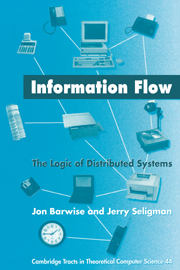Book contents
- Frontmatter
- Contents
- Preface
- Part I Introduction
- Part II Channel Theory
- 4 Classifications and Infomorphisms
- 5 Operations on Classifications
- 6 Distributed Systems
- 7 Boolean Operations and Classifications
- 8 State Spaces
- 9 Regular Theories
- 10 Operations on Theories
- 11 Boolean Operations and Theories
- 12 Local Logics
- 13 Reasoning at a Distance
- 14 Representing Local Logics
- 15 Distributed Logics
- 16 Logics and State Spaces
- Part III Explorations
- Answers to Selected Exercises
- Bibliography
- Glossary of Notation
- Index of Definitions
- Index of Names
8 - State Spaces
Published online by Cambridge University Press: 05 November 2011
- Frontmatter
- Contents
- Preface
- Part I Introduction
- Part II Channel Theory
- 4 Classifications and Infomorphisms
- 5 Operations on Classifications
- 6 Distributed Systems
- 7 Boolean Operations and Classifications
- 8 State Spaces
- 9 Regular Theories
- 10 Operations on Theories
- 11 Boolean Operations and Theories
- 12 Local Logics
- 13 Reasoning at a Distance
- 14 Representing Local Logics
- 15 Distributed Logics
- 16 Logics and State Spaces
- Part III Explorations
- Answers to Selected Exercises
- Bibliography
- Glossary of Notation
- Index of Definitions
- Index of Names
Summary
State-space models are one of the most prevalent tools in science and applied mathematics. In this lecture, we show how state spaces are related to classifications and how systems of state spaces are related to information channels. As a result, we will discover that state spaces provide a rich source of information channels. In later lectures, we will exploit the relationship between state spaces and classifications in our study of local logics.
State Spaces and Projections
Definition 8.1. A state space is a classification S for which each token is of exactly one type. The types of a state space are called states, and we say that a is in state σ if a ⊨s σ. The state space S is complete if every state is the state of some token.
Example 8.2. In Example 4.5 we pointed out that for any function f : A → B, there is a classification whose types are elements of B and whose tokens are elements of A and such that a ⊨b if and only if b = f(a). This classification is a state space and every state space arises in this way, so another way to put the definition is to say that a state space is a classification S in which the classification relation ⊨s is a total function. For this reason, we write states(a) for the state σ of a in S.
- Type
- Chapter
- Information
- Information FlowThe Logic of Distributed Systems, pp. 103 - 116Publisher: Cambridge University PressPrint publication year: 1997



